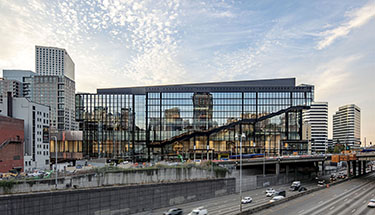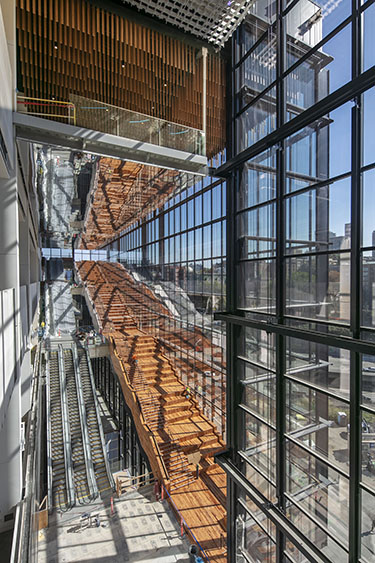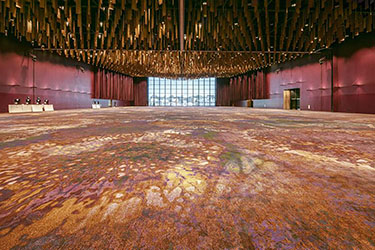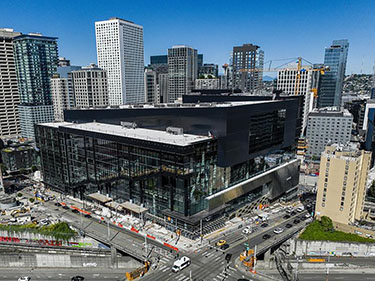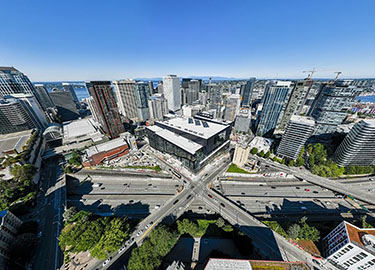|
Subscribe / Renew |
|
|
Contact Us |
|
| ► Subscribe to our Free Weekly Newsletter | |
| home | Welcome, sign in or click here to subscribe. | login |
Real Estate
| |
January 26, 2023
Seattle Convention Center opens with solar panels, wooden stairs, optimistic pols
Real Estate Editor
Yesterday marked the ceremonial opening of the new Summit portion of Seattle Convention Center, now using 900 Pine St. as its address. The public can tour the building tomorrow, after first registering at http://www.seattleconventioncenter.com.
LMN designed the five-story high-rise structure, which features a large atrium descending from its ceiling skylight down to the loading dock level below grade. The builders, in a joint venture, were Clark Construction Group, of Maryland, and Lease Crutcher Lewis. They broke ground in August 2018. Matt Griffin's Pine Street Group led the entire effort.
A dais full of prominent executives and politicians lauded the over $1.9 billion project, which spans some 1.5 million square feet over a full city block. (The original convention center, now dubbed Arch, is a few steps south.)
Gov. Jay Inslee said, “This is a huge investment,” and offered shoutouts to taxpayers and union workers, including the project's one fatality, Bryan Phillips. The governor predicted that Summit would help bring a return of tourists and conventiongoers. “We're on the rebound,” he said.
King County Executive Dow Constantine recalled, “It was more than a decade ago that we began this,” and likewise anticipated “a big boost to our economic fortunes.” The county made the funding possible, via a lodging tax that supported SCC bond issues. And it sold the old Convention Place bus center to SCC for about $275 million.
Mayor Bruce Harrell said the mega-project was a rare example where “the system is working. It's kinda corny, but it's true.” Looking ahead, he said, “I'm bullish on downtown. I believe in downtown.”
The building speaks for itself: vast and utilitarian, but with LMN's smart design enlivening a great big box. There have to be huge ballrooms, large meeting halls, lots of escalators and the ability to hold multiple events on different floors all at once.
Unseen to the public, freight elevators have to move huge amounts of event-related equipment, displays, food and more. Trucks and buses have to enter below. For a sense of scale, March's coming Emerald City Comic Con is expected to draw some 30,000 attendees.
Mark Reddington and his colleagues at LMN have made the cube as transparent as possible, with large open faces on almost every aspect. Views are impressive in almost every direction — including the upper levels of the Camlin, Olive Tower and Paramount Theatre apartments. (Residents at those latter two will now have to draw their blinds at night.)
In the top-floor ballroom, with a divisible 58,000 square feet, the northeast-facing window rises a commanding 63 feet in height.
Cantilevered south over Pine is LMN's dramatic wooden hillclimb feature, with companion seating areas and USB ports. Reaching from the second floor to top floor, it's sure to become a staple for selfies and Instagram. Proceeding upward, it's also a little startling to be at bird's-eye level over the traffic on Interstate 5.
There are nooks and eddies everywhere in the building for private confabs. Lobbies are much wider than at the 35-year-old Arch, which was also designed by LMN. The signage and wayfinding, much of it on video displays, is crisp and clear. Each level also has a distinctive floor sign marker intended to evoke local industry. One giant 3, for example, is filled with aluminum rivets of the type Boeing uses.
Retail bays and outdoor seating areas ring much of the Summit block. It also helps that the gently sloping site makes Summit seem less static — like it's almost sliding down Capitol Hill, and hanging over the freeway. The grade is also echoed by an angled roof.
Summit is targeting LEED Gold certification, with green features including LED lighting, rooftop solar panels, a 14,000-square-foot terrace, plant-based acoustic ceiling tiles, low-flow plumbing, and EV charging for some of the 700 underground parking stalls.
In addition to copious public art, old logs and timber have been salvaged for decorative use. Some of the old wooden beams on the ground floor came from the old Honda building that once stood on the corner of Olive Way.
Among the confirmed future retail tenants are the pizza place Bomba, from Ethan Stowell; Wild Rye, a bakery; and Pike Brewing. Two other prospective local food and beverage tenants are interested, according to SCC. Some of those retail bays open exclusively to Pine, while the lobby area of Summit will be open to the public.
That latter accessibility speaks to the community benefit package required for the final project approval back in 2017. All dollar figures have shifted since then, along with the extra $342 million bond issue required two years back, when the lodging tax was brought to a halt by the pandemic.
SCC today values the public art component at $6.5 million, with another $40 million for creation and preservation of affordable housing units. Those sums are part of the larger $93 million in community benefits, which includes improvements to the Pike-Pine corridor.
Not part of Summit itself, but included in the entire SCC permit is Hudson Pacific Properties' office tower at 1000 Olive Way. That's now risen to about 12 stories (of 16), with completion anticipated early next year.
Situated on the triangle northwest of Summit, that was also designed by LMN — as is the planned 29-story apartment tower, west of the offices, where no developer has yet acquired that MUP and condominium rights. Pine Street Group's Griffin insisted, “We're working on it!”
He noted that future renters there could use the Summit lobby as an informal escape from the claustrophobia of work-from-home, while still lugging their laptops. (There's free Wi-Fi for now, at least; and the bike racks outside are excellent.) Griffin will exit his company this year, after a decade's work on Summit and its two companion buildings — but won't fully retire from the biz.
In his opening remarks, SCC board chair Frank Finneran projected that Summit might generate $250 million a year in visitor spending (that extends well beyond the building), and create many new jobs. (SCC is hiring, as it advertises on almost every video screen at Summit.) But those numbers, like $19 million in annual tax revenue, like some 3,900 new permanent jobs — direct and indirect — predate the pandemic and public acceptance of Zoom.
Downtown visitors of all stripes are up compared to last year, but not yet back to 2019 levels, according to data compiled by the Downtown Seattle Association. And hotel room bookings for December were at 71% of 2019 levels, per the DSA. But that's been mostly tourists, not conventioneers.
What's next at Summit? About 4,000 attendees are expected next month for the Conference on Retroviruses and Opportunistic Infections. Many, no doubt, will be wearing masks.
Brian Miller can be
reached by email at brian.miller@djc.com or by phone at (206) 219-6517.



